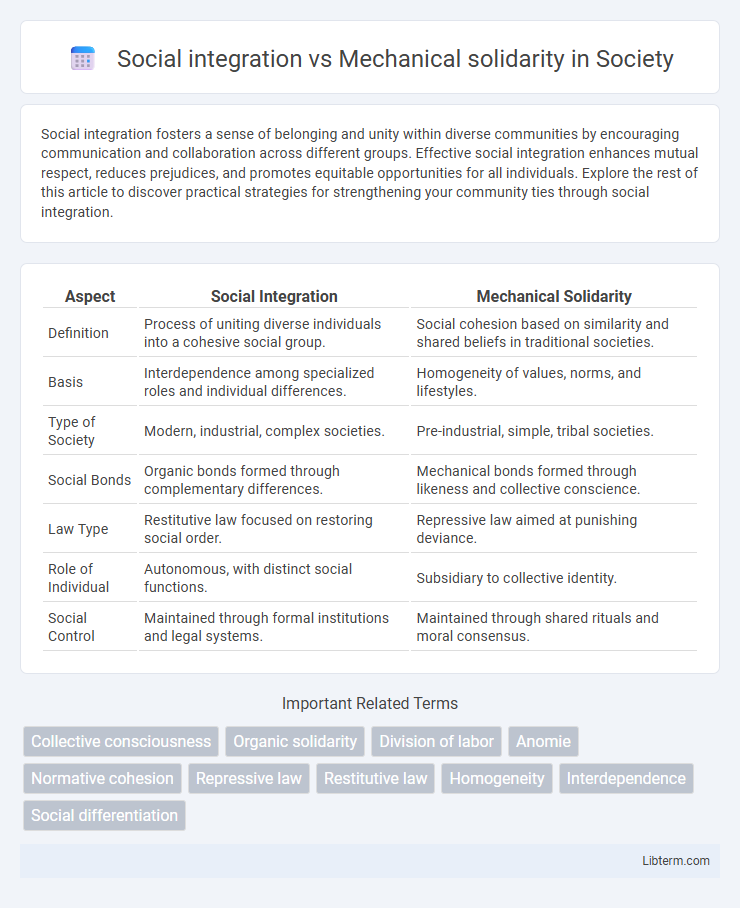Social integration fosters a sense of belonging and unity within diverse communities by encouraging communication and collaboration across different groups. Effective social integration enhances mutual respect, reduces prejudices, and promotes equitable opportunities for all individuals. Explore the rest of this article to discover practical strategies for strengthening your community ties through social integration.
Table of Comparison
| Aspect | Social Integration | Mechanical Solidarity |
|---|---|---|
| Definition | Process of uniting diverse individuals into a cohesive social group. | Social cohesion based on similarity and shared beliefs in traditional societies. |
| Basis | Interdependence among specialized roles and individual differences. | Homogeneity of values, norms, and lifestyles. |
| Type of Society | Modern, industrial, complex societies. | Pre-industrial, simple, tribal societies. |
| Social Bonds | Organic bonds formed through complementary differences. | Mechanical bonds formed through likeness and collective conscience. |
| Law Type | Restitutive law focused on restoring social order. | Repressive law aimed at punishing deviance. |
| Role of Individual | Autonomous, with distinct social functions. | Subsidiary to collective identity. |
| Social Control | Maintained through formal institutions and legal systems. | Maintained through shared rituals and moral consensus. |
Understanding Social Integration: Definition and Importance
Social integration, defined as the process by which individuals form cohesive relationships within a society, is crucial for maintaining social order and unity. Mechanical solidarity arises when social integration is based on shared beliefs, values, and traditions in homogenous groups, fostering a collective conscience. Understanding social integration highlights its role in promoting cooperation and stability in both simple and complex societies.
Exploring Mechanical Solidarity: Key Characteristics
Mechanical solidarity is characterized by a strong collective conscience, where individuals share similar beliefs, values, and lifestyles, fostering social cohesion through homogeneity. This form of social integration is typical in traditional, small-scale societies with a limited division of labor, where social roles are largely interchangeable. Social bonds in mechanical solidarity rely on similarity and shared moral understandings, which contrast with the interdependence found in organic solidarity.
Historical Context: Origins of Social Integration and Mechanical Solidarity
Mechanical solidarity, rooted in Emile Durkheim's research on pre-industrial societies, emerges from the homogeneity of individuals sharing similar work, values, and beliefs, fostering social cohesion through collective consciousness. Social integration, contrastingly, evolves alongside the division of labor in industrialized societies, where increased specialization and interdependence among diverse individuals enhance bonds through complementary roles. The historical context of social integration reflects the transition from traditional, low-complexity communities to modern, complex societies marked by organic solidarity and mutual reliance.
Emile Durkheim’s Perspective on Social Cohesion
Emile Durkheim distinguishes social integration and mechanical solidarity as key components of social cohesion, where mechanical solidarity characterizes traditional societies unified by shared beliefs and similarities, fostering collective conscience. In contrast, social integration in modern societies arises from organic solidarity, where individuals perform specialized roles, creating interdependence and social bonds through division of labor. Durkheim's perspective highlights that social cohesion transitions from homogeneity to complexity, emphasizing how diverse social functions maintain societal unity.
Differences Between Social Integration and Mechanical Solidarity
Social integration refers to the process by which individuals form cooperative social relationships and shared values within a diverse, complex society, emphasizing organic solidarity based on interdependence. Mechanical solidarity, as described by Durkheim, characterizes traditional societies where cohesion arises from homogeneity and shared beliefs, enforcing conformity through collective consciousness. The key difference lies in social integration's focus on dynamic, functional interconnections among diverse individuals, while mechanical solidarity depends on uniformity and sameness to maintain social order.
Social Integration in Modern Societies
Social integration in modern societies is characterized by complex interdependence and diverse social roles that foster cohesion despite individual differences. It relies on organic solidarity, where individuals contribute specialized functions, creating a web of cooperation essential for societal stability. This form of integration contrasts with mechanical solidarity, which is rooted in similarity and shared beliefs typical of traditional societies.
Mechanical Solidarity in Traditional Societies
Mechanical solidarity predominates in traditional societies where social cohesion stems from shared beliefs, values, and collective consciousness. Individuals perform similar tasks and roles, resulting in strong social bonds and uniformity in life experiences. This type of solidarity contrasts with modern societies, where social integration relies more on the interdependence of specialized roles.
Impacts on Community Structure and Relationships
Mechanical solidarity, characterized by homogeneity and shared beliefs, fosters strong, cohesive community ties through collective consciousness and similarity in roles. Social integration under organic solidarity promotes interdependence and diversity, leading to complex social networks with specialized roles that enhance cooperation despite individual differences. The impact on community structure shows mechanical solidarity creating tight-knit, uniform groups, while organic solidarity develops dynamic, interconnected societies with greater social flexibility and adaptability.
Challenges and Critiques of Both Concepts
Social integration faces challenges in addressing individual autonomy and cultural diversity, often criticized for promoting conformity at the expense of personal freedoms. Mechanical solidarity struggles with rigidity, as its emphasis on shared beliefs and similarities can hinder social change and adaptability in complex societies. Both concepts are critiqued for oversimplifying social cohesion, neglecting dynamic interactions and power imbalances within modern social structures.
Towards a Balanced Social Cohesion: Blending Integration and Solidarity
Social integration emphasizes the inclusion of diverse individuals into a cohesive community through shared norms and interpersonal connections. Mechanical solidarity relies on similarities and collective conscience to maintain social order in traditional societies. Achieving balanced social cohesion requires blending the dynamic adaptability of social integration with the unifying strength of mechanical solidarity to foster both diversity and unity.
Social integration Infographic

 libterm.com
libterm.com